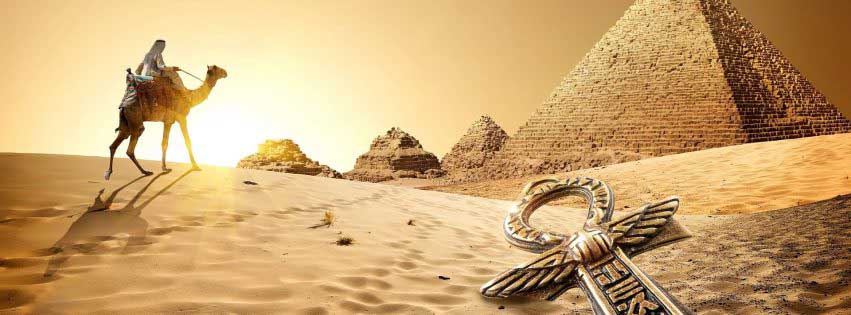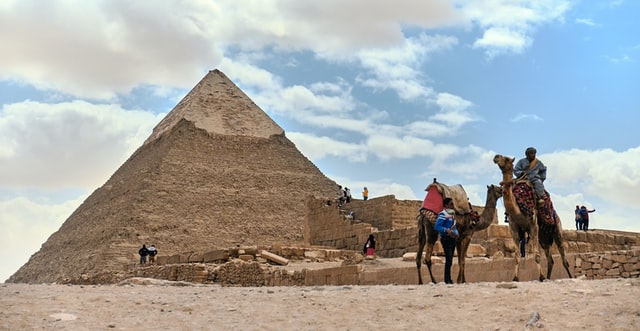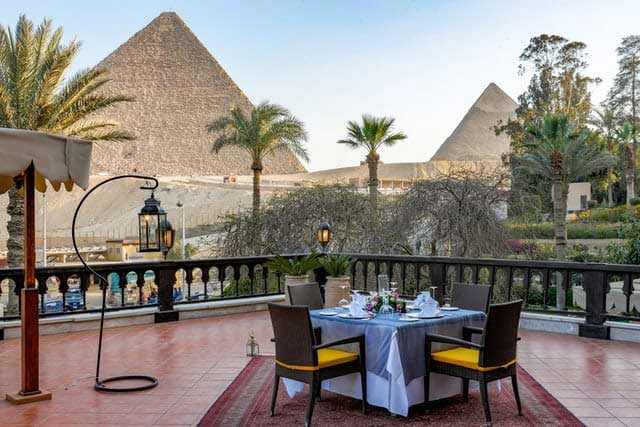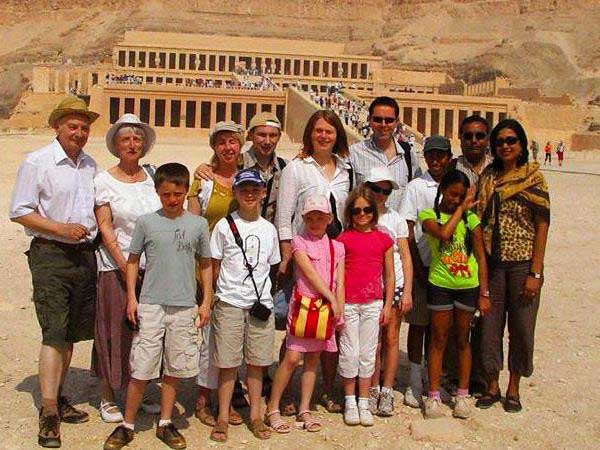Colossi of Memnon

The two faceless Colossi of Memnon, originally representing Pharaoh Amenhotep III, rising majestically about 18m from the plain, are the first monuments tourists see when they visit the west bank. These magnificent colossi, each cut from a single block of stone and weighing 1000 tonnes, sat at the eastern entrance to the funerary temple of Amenophis III, the largest on the west bank. Egyptologists are currently excavating the temple and their discoveries can be seen behind the colossi.
Since 1350 BCE, they have stood in the Theban Necropolis, located west of the River Nile from the modern city of Luxor.
It was acting as guardians to the Temple of Amenhotep III. The Colossi of Memnon was meant to protect the Pharaoh’s temple from evil. Even though after the temple was destroyed by a severe earthquake, the Colossi of Memnon remains standing strongly for thousands of years.
This article contains information about visiting The Colossi of Memnon including:
What is the Colossi of Memnon?
The twin statues depict Amenhotep III (14th century BCE) in a seated position, his hands resting on his knees and his gaze facing eastwards (actually ESE in modern bearings) towards the river. Two shorter figures are carved into the front throne alongside his legs: these are his wife Tiye and mother Mutemwiya. The side panels depict the Nile god Hapi.
The statues are made from blocks of quartzite sandstone which was quarried at el-Gabal el-Ahmar (near modern-day Cairo) and transported 675 km (420 mi) overland to Thebes (Luxor). The stones are believed to be too heavy to have been transported upstream on the Nile. The blocks used by later Roman engineers to reconstruct the northern colossus may have come from Edfu (north of Aswan). Including the stone platforms on which they stand – themselves about 4 m (13 ft) – the colossi reach a towering 18 m (60 ft) in height and weigh an estimated 720 tons each. The two figures are about 15 m (50 ft) apart.
Both statues are quite damaged, with the features above the waist virtually unrecognizable. The southern statue comprises a single piece of stone, but the northern figure has a large extensive crack in the lower half and above the waist consists of 5 tiers of stone. These upper levels consist of a different type of sandstone, and are the result of a later reconstruction attempt, which William de Wiveleslie Abney attributed to Septimus Severus. It is believed that originally the two statues were identical to each other, although inscriptions and minor art may have varied.
Some tiny parts of the temple that stood behind the colossi remain and more is being uncovered now that the excavation is underway. Many statues, among them the huge dyad of Amenhotep III and his wife Tiye that now dominates the central court of the Egyptian Museum in Cairo, were later dragged off by other pharaohs, but much still remains beneath the silt. A stele, also now in the Egyptian Museum, describes the temple as being built from ‘white sandstone, with gold throughout, a floor covered with silver, and doors covered with electrum’. No gold or silver has yet been found, but if you wander behind the colossi, you can see the huge area littered with statues and masonry that had long lain under the ground.
Where is the Colossi of Memnon Located?
In the West Bank of Luxor Egypt, two magnificent twin statues image of pharaoh Amenhotep III and two smaller statues carved by his feet (one being his wife and the other his mother), stands graciously in the horizon of the magnificent Luxor horizons.
The two statues, each measuring 60 feet tall, stands in the entrance of Amenhotep III’s mortuary temple. They are famously named by the name of Colossi of Memnon due to a phenomenon produced by one of the statues after an earthquake.
Originally built in the Theban Necropolis in the west of the Nile River in the modern city of Luxor, the Colossi of Memnon, two colossal statues made of quartzite sandstone, which archaeologists believe was quarried at El-Gabal el-Ahmar, located near modern Cairo and then transported 420 miles overland to the ancient city of Thebes, remain after thousands of years.
The Legend of the song
The colossi were already a great tourist attraction during Graeco-Roman times, when the statues were attributed to Memnon, the legendary African king who was slain by Achilles during the Trojan War. The Greeks and Romans considered it good luck to hear the whistling sound emitted by the northern statue at sunrise, which they believed to be the cry of Memnon greeting his mother Eos, the goddess of dawn. She in turn would weep tears of dew for his untimely death. All this was probably due to a crack in the colossus’ upper body, which appeared after the 27 BC earthquake. As the heat of the morning sun baked the dew-soaked stone, sand particles would break off and resonate inside the cracks in the structure. After Septimus Severus (193–211 AD) repaired the statue in the 3rd century AD, Memnon’s plaintive greeting was heard no more.
How to Visit The Colossi of Memnon?
The Colossi of Memnon are usually included on guided tours of the ancient Thebes necropolises of the Valleys of the Kings and Queens, and the Temple of Hatshepsut.
The colossi are just off the road, before you reach the Antiquities Inspectorate ticket office, and are usually being snapped and filmed by an army of tourists. Yet few visitors have any idea that these giant enthroned figures are set in front of the main entrance to an equally impressive funerary temple, the largest in Egypt, the remains of which are slowly being brought to light.
When was The Colossi of Memnon built?
Pharaoh Amenhotep III reigned in Egypt during the 18th Dynasty from 1386 to 1349. During his kingdom, Egypt experienced a time of great prosperity and artistic progress, this era was known as the Old Kingdom. During the Old Kingdom, the architectural work improved tremendously in Egypt, and most of these monuments are still standing today.
Many of these majestic monuments were built during Amenhotep III’s 39 years of reign including the Colossi of Memnon which construction was completed by 1350 BC. The Colossi of Memnon was constructed in front of which once was Amenhotep III’ temple (destroyed by an earthquake soon after its completion). Amenhotep Temple served as a funerary temple to the Pharaoh Amenhotep III. Due to an earthquake at 27 BC the Colossi of Memnon was partially destroyed and then restored by Roman emperors during the Roman Empire in ancient Egypt.
The story behind the name of Memnon
The modern Arabic name is Kom el-Hatan, but it is generally known by the Roman name as the Temple of Memnon. Memnon was a hero of the Trojan War, a King of Ethiopia who led his armies from Africa into Asia Minor to help defend the beleaguered city but was ultimately slain by Achilles. Memnon (whose name means the Steadfast or Resolute) was said to be the son of Eos, the goddess of dawn. He was associated with colossi built several centuries earlier, because of the reported cry at dawn of the northern statue, which became known as the Colossus of Memnon. Eventually, the entire Theban Necropolis became generally referred to as the Memnonium making him “Ruler of the west” as in the case of the god Osiris who was called chief of the west.
Recommended Tours to The Colossi of Memnon
The Colossi of Memnon are usually included on guided tours of the ancient Thebes necropolises of the Valleys of the Kings and Queens, and the Temple of Hatshepsut:
Tips and advices before visiting Luxor Egypt
What are the best tours in Luxor?
What are the best tours in Luxor?
Luxor Full-Day Tour: Valley of Kings & Queens – Hatchepsut Temples And More
2 days trip to Luxor from Hurghada
Luxor and Aswan from Hurghada, 2 days trip
Luxor day tour from Marsa Alam
2 days trip to Luxor from Marsa Alam
2 days trip to Luxor and Aswan from Marsa Alam
2 Days Tour to Aswan and Abu Simbel from Luxor by Bus
Private guide Full day tour Dendara and Abydos Temples from Luxor
Tour to Ramesseum, Habu Temples, and the Valley of the Nobles
Private Full-Day Luxor Highlights East and West Banks
Luxor Hot Air Balloon Ridding in Luxor
How many days do you need in Luxor?
How many days do you need in Luxor?
Luxor requires a minimum of 3 days. There is so much to see and do so you will be on the go the whole time. I’d say the minimum time needed to visit Luxor is two days, but you can easily spend longer as there are so many sites, and it’s worth taking the time to enjoy the atmosphere.
Is Luxor worth visiting?
Is Luxor worth visiting?
Luxor and Cairo are exceedingly different places and yes Luxor is well worth visiting. This, however, doesn’t mean you have to do it. If you want to see iconic sites such as the Valley of the King’s and Karnak Temple (to name just two of the many sites in and around Luxor), then you have no choice.
How do you get to Luxor?
How do you get to Luxor?
Egypt Air flies four times daily direct to Luxor International Airport from Cairo International Airport. Flights take one hour, and ticket prices start at around US$145 in the high season from December to February. If you’re traveling in low season, flight prices often drop.
What are the most famous tourist attractions in Egypt
What are the most famous tourist attractions in Egypt?
Egypt has so much for travelers to see and do, it’s the perfect country for a mix of activities combining culture, adventure, and relaxation. Find the best places to visit with our list of the top tourist attractions in Egypt.
- Pyramids of Giza
- Valley of the kings
- Luxor’s Karnak Temple
- The Egyptian Museum
- Christian and Islamic Cairo
- The White Desert and Baharyia Oasis
- Siwa Oasis
- Abu simbel Temples
- Aswan
- Alexandria
- St. Catherine’s Monastery
- The Nubian village
- Nile River Cruise
- Hurghada
- South of Sinai
What is the best Nile cruise in Egypt
What is the best Nile cruise in Egypt?
Sonesta Moon Goddess.
Oberoi Philae Nile Cruise.
Oberoi Zahra Nile Cruise.
Sonesta Star Goddess Cruises.
M/S Esplanade Cruise.
Nile Goddess Cruise.
What do you wear on a Nile Cruise
What do you wear on a Nile Cruise?
There are no “formal nights” or other theme nights on Nile Cruises, so you can just go with resort casual. Slacks are fine, as are dresses. Bare shoulders are acceptable in the cruise dining room, so feel free to wear what you feel good in.
How Much does a Nile River Cruise Cost
How Much does a Nile River Cruise Cost?
The cost of a standard Nile River cruise between Luxor & Aswan will range from $450 to $750 for 3,4, or 7 nights. The cost of a high Luxury Nile River cruise between Luxor & Aswan will range from $790 to $1299 for 3,4, or 7 nights.
How far is Luxor from Marsa Alam
How far is Luxor from Marsa Alam?
The distance between Marsa Alam and Luxor is 237 km. The road distance is 355.7 km.
What are the best day trips in Egypt
Why is Abu Simbel famous?
Why is Abu Simbel famous?
It was dedicated to the gods Amun, Ra-Horakhty, and Ptah, as well as to the deified Ramesses himself. It is generally considered the grandest and most beautiful of the temples commissioned during the reign of Ramesses II, and one of the most beautiful in Egypt.
How far is Abu Simbel from Luxor?
How far is Abu Simbel from Luxor?
The distance between Luxor and Abu Simbel temples is 388 km. The road distance is 477.5 km.
What are the best tours in Aswan?
What are the best tours in Aswan?
These experiences are the best in Aswan
Visiting Philae temple. Aswan High Dam, and the Unfinished Obelisk
Private Day Tour to Abu Simbel Temples from Aswan
2 nights Nile cruise includes tours from Aswan to luxor
4-Day 3-Night Nile Cruise from Aswan to Luxor – Private Tour
Aswan day tour from Marsa Alam
2 days trip to Aswan and Abu Simbel from Marsa Alam
2 days trip to Aswan and Abu Simbel from Hurghada
Kalabsha temple and the Nubian museum tour
Related Articles
Related
Best places to visit in Egypt
Are you currently planning a trip? Are you wondering what are the best places to visit in Egypt? What is the best time to visit Egypt or where to stay in Egypt?
How lucky you are, you have just found your ultimate guide.
Egypt is considered the oldest travel destination on globe. In a land where the past sits overlooking the present, Egypt is a country that fills the senses. Egypt is a land with well-defined boundaries. To the east and west are vast deserts. To the north is the Mediterranean sea. To the south is the land of Nubia.
Egypt has amassed approximately 7000 years of history and civilization; but besides its breathtaking Pharaonic and other ancient attractions, Egypt also currently possesses unique cultures, traditions, food, people and, exciting activities. For centuries, tourists have flocked to Egypt to admire its ancient pyramids and temples. The country also has its fair share of natural wonders. The River Nile is the longest in the world, and the Red Sea coast is a playground for resort-style relaxation and adventurous watersports.
Seth
Also known as Set, Setekh, Suty and Sutekh, Seth was the god of chaos, darkness, violence, evil, deserts, storms, and one of the Osirian gods. In the Osiris myth, he is the murderer of Osiris (in some versions of the myth, he tricks Osiris into laying down in a coffin and then seals it shut.)
Ancient Egyptian Gods And Goddesses
For all ancient Egyptians, the world was filled with mystery. Much of what they experienced in the world around them was unknowable and frightening. The ancient Egyptian gods and goddesses represented aspects of the Egyptians’ natural and “supernatural” surroundings and helped them understand its many aspects.



















